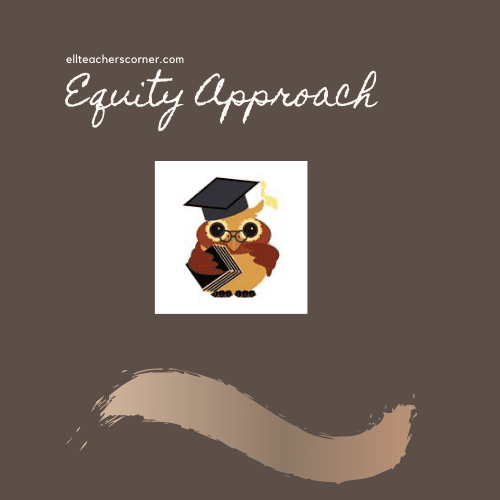
Confianza also has a blog on Strategies for integrating language and content in remote learning settings. This is part two of strategies for integrating language and content.
Reasons Teaching Language and Content
5 Important Reasons Teaching Academic Language and content are:
- When teachers teach language and content, students learn not only the important academic content they need, but also the academic English associated with the different content areas
- As students study content, they are exposed to the language of each academic subject area in a natural context
- Activities provide an authentic context for students to develop academic language in a particular area
- Students have a real purpose for developing an additional language, since they are learning interesting academic content
- It is important to organize the content teaching over an extended period. This way, it provides students multiple opportunities to develop academic language as they study content
Mary Soto, David E. Freeman, and Yvonne S. Freeman, authors of Equitable Access for English Learners, provided an Unit of Inquiry as an example of the benefits teaching academic language and content.
Putting Unit Into Context: Natural Disasters
An upper elementary school teacher, Gloria, teaches in a large rural school district in California near the San Francisco Bay area. Most of her students attended school in the same district since kindergarten. Some students are monolingual speakers, but many are Spanish speakers.
Bilingual education for Spanish speakers is offered at the district in the lower grades. By the time Gloria’s students come to her, they have usually been exited from the language support programs. Gloria suspects that several of her students are long term English Learners. These students speak and understand conversational English, but struggle with academic reading and writing. She has in her classroom students whose home language includes Hmong, Vietnamese, Arabic, Punjabi, and Laotian,
As these Long Term English Learners move up in grades, it becomes increasingly critical for teachers to make complex academic content comprehensible for them, according to the authors. Gloria finds ways to engage all her students by using activities connected to units of inquiry. The big idea around the readings answers the big question “What are natural disasters and how do they affect us and the world around us?”
Previewing Activities: Drawing and Building on Background Knowledge
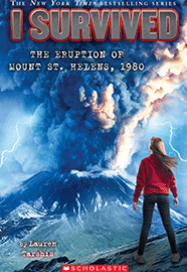
Students in Gloria’s class are interested in stories about real people, as well as scary stories. Gloria displays several books of the I Survived book series from L. Tarshis. Students are divided into groups of three. Gloria asks them to list on paper at least five different disasters they identify by looking at the book covers.
Students must read the text on the front and back covers to get more information. Once each group has chosen five disasters, they use their background knowledge and information from reading the covers of the I Survived books.
Students, drawing on this information, compose one sentence describing each disaster on their list. Then, they decide which disaster they think is the most dangerous and why.
Gloria provides this sentence frame to help her emergent bilinguals as they report:
“__________________ are the most dangerous of the natural disasters because _______________”
Each group shares the sentence from the disaster they thought was most dangerous, and the conclusion they came to about why that natural disaster was the most dangerous. Students do not agree on which disasters are the most dangerous. Many students share that they or someone they know has experienced one or more natural disasters, including earthquakes, hurricanes, forest fires, and tornadoes.
The previewing activity is based on the following:
Standard based skills – draw on the background knowledge, make inferences, gather information from texts.
Content objective – Students will identify and describe types of natural disasters, from viewing pictures and reading front and back book covers.
Language Objective – Students will construct a complete sentence naming a type of natural disaster, and giving reasons why it is the most dangerous, using this sentence frame: “______________________ are the most dangerous of the natural disasters because __________________”
You can use other strategies for building on background knowledge, from 5 Ways to Build Background Knowledge post.
Natural Disasters KW Chart
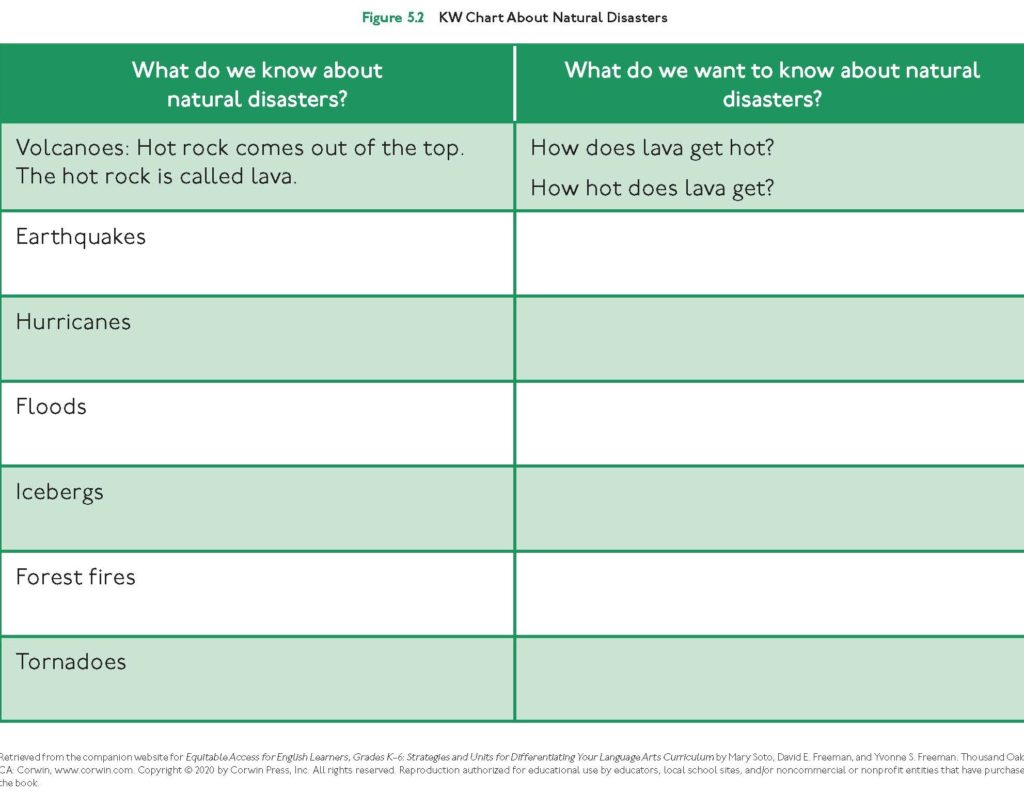
The next step is to fill out a KW chart. Students work together by listing the natural disasters they found in I Survived Books. They brainstorm for each one what they already know about this type of disaster.
Students use the sentences they had created in their groups and add questions about each disaster type. (Shown in above KW Chart)
Students are reminded about questions that begin with wh- or how are followed by a verb form. Gloria puts sample questions on the board for students to use as models.
After the activity is complete, Gloria posts pieces of butcher paper around the room labeled at the top with the names of the different disasters students have talked about.
Students will write what they are learning as the unit progresses.
Building Background: Videos on Natural Disasters
Gloria uses free National Geographic resources below:
https://www.nationalgeographic.org/activity/extreme-weather-on-our-planet/
https://www.nationalgeographic.org/activity/types-of-volcanic-eruptions/
https://www.nationalgeographic.org/forces-nature/
https://www.nationalgeographic.org/media/ocean-currents-and-climate/
Students are to discuss with a partner the following questions for each video:
“What was the natural disaster that is featured?”
“Where did the disaster take place?”
“What kinds of destruction did the disaster cause?”
“Who was affected by the disaster?”
Students working with their partners to write a one-paragraph summary of the video, including the key information they have discussed. Students also add the information to the various disaster charts around the room, showing what they are learning.
Gloria explains to the students how to write a paragraph. She states, “A well-written paragraph begins with a topic sentence. The topic sentence should tell what the natural disaster they viewed was. The other sentences should provide details about the disaster. Each of the supporting sentences should begin with a noun phrase or a pronoun that refers to the disaster.” (pg 150) Gloria shows students a short model paragraph about a volcano that she has written:
“The natural disaster was a volcano that erupted in Bali. It destroyed the plants and animals living nearby. The volcano also destroyed many houses, and people had to evacuate.”
Building Background is based on the following:
Standards based skills – integrate information on a topic from a media source; provide a summary of information.
Content Objective – Students will identify key information from a video about a natural disaster and its effect on people and the environment.
Language objective – Student will write a cohesive paragraph by starting each sentence with a noun or pronoun that refers to the disaster being described.
MultiLingual Word Wall
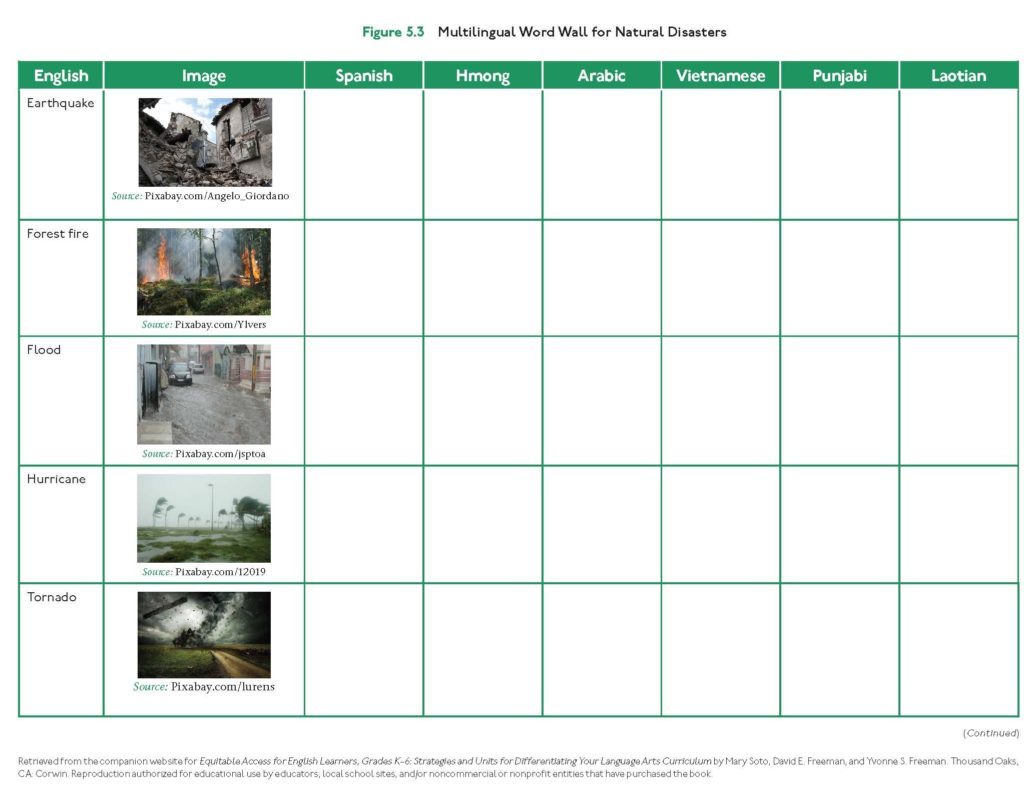
A multilingual word wall is posted on the wall with the different disaster the class is studying. (See above chart) Gloria invites students who speak home languages other than English to put an equivalent word from their language in each row. In addition to Spanish, students who speak Hmong, Vietnamese, Arabic, Punjabi, and Laotian add words in each row.
Students research on the internet and ask family members to write the word in their language.
Authors note to reinforce content specific vocabulary, students work in groups to find and print an image for each type of disaster.
I Survived Book Posters

Students are divided into groups of 3 or 4. Some groups are made up of students who speak the same home language. Each group received an I survived book to read together. Students in each group make a poster listing the theme of each book, summarizing the key events and details of the disaster, and explain how the main characters survived the disaster.
When each group is finished with the poster, they make a presentation about the book they read. Posters are displayed around the room and left up for reference throughout the unit.
I Survived Book Posters is based on the following:
Standardbased skills – determine main ideas or themes in a text, provide supporting details, list key events.
Content Objective – Students will identify the characteristics of a natural disaster and its effects on people and nature.
Language Objective – Students will orally present key events in order of occurence, using sequence signal words. Students wil use descriptive adjectives as they describe how the characters survived.
Finding Textual Evidence
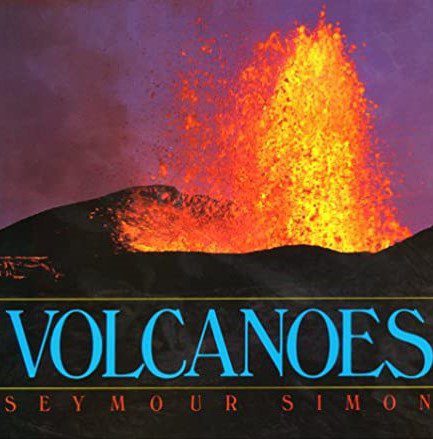
Gloria uses an anchor text called Volcanoes by Simon Seymour. This is the first piece students read from their language arts program.
Seymour illustrates and describes volcanoes with the beliefs of early people had about volcannoes in the beginning of the book. Then, he desribes types of volcanoes and showing how they are forms. Seymour discusses different volcanoes, includeing Mount St. Helens and its eruption.
Gloria takes a picture walk of the book. She projects each page on the whiteboard. Students are asked to comment on the photographs and anything they notice during the quick picture walk through the text.
Afterwards, students read through the text on their own. Gloria asks students to pick out the main idea from each section and list one or two sentences from the text that provide textual evidence to support the main idea.
Gloria works with the students to write first two entries for the main idea and textual evidence. Below is an example:
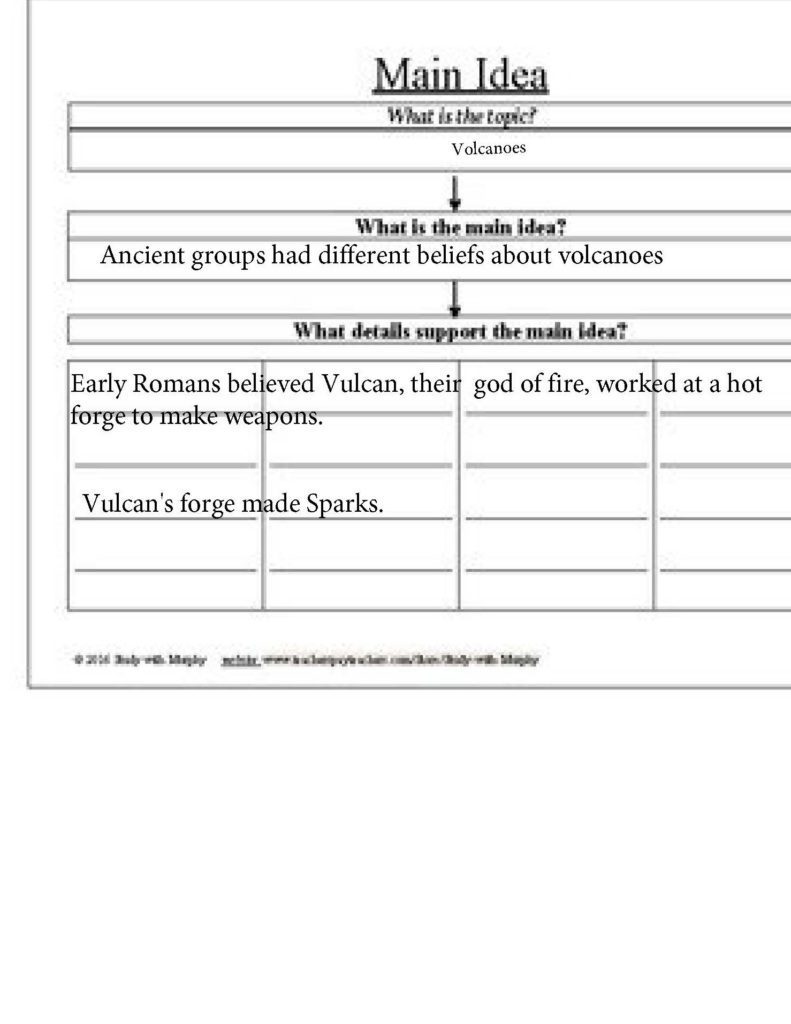
Many of her students have not developed grade-level reading and writing skills, Gloria decides to conduct a formative assessement of the students’ writing. Here is her writing rubric:
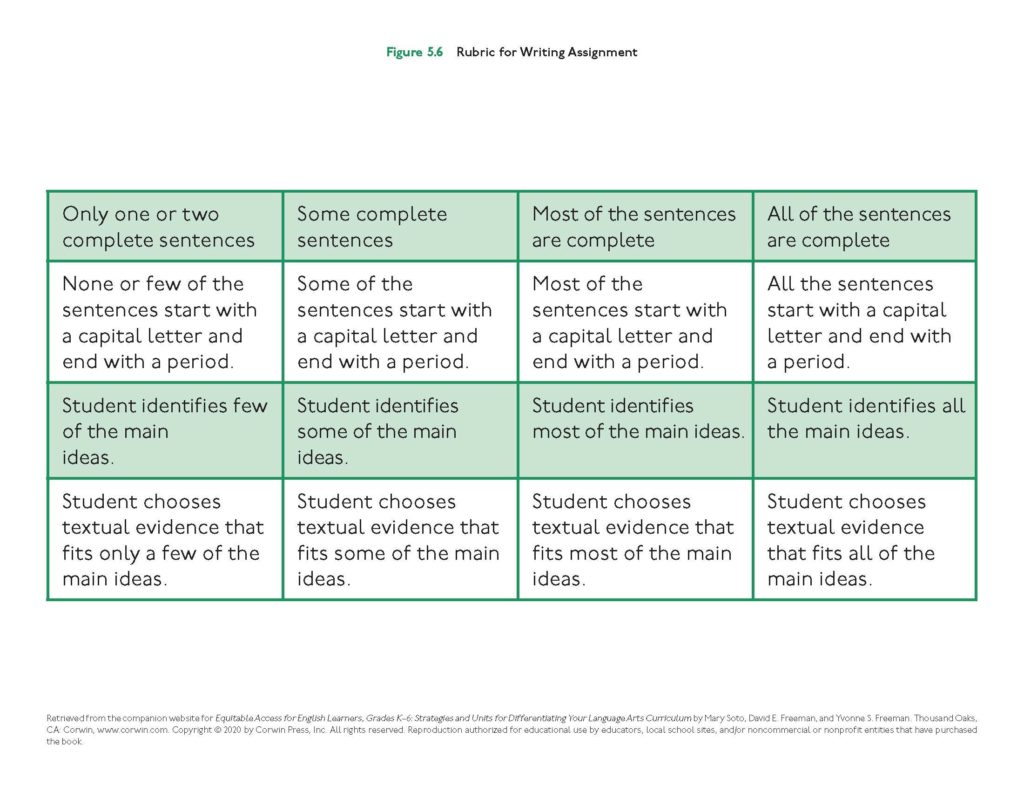
Finding textual evidence is based on the following:
Standard based skills – determine main ideas or themes in a text and provide textual evidence, provide supporting details, list key events.
Content objective – Students will identify types of volcanoes, how they are formed, and how and why they erupt.
Language Objective – Drawing on the information in the text, students will write complete sentences to indicate key ideas and supporting textual evidence.
Found Poems
Studnents meet in groups and share their main ideas and the textual evidence they found to support each idea the next day.
Gloria wants to further develop students’ understanding of reading and learning the academic vocabulary. She asks each group to write a found poem.
Each student is given strips of paper and he or she chooses phrases and key words from their main ideas and textual eveidence charts and write those words and phrases o their slips of paper. Then, Gloria asks students to put the words and phrases in an order that makes sense to them to create a found poem that represents what they now know about volcanoes. She explains that they can repeat key words or phrases to make their poems if they wish.
Students move their slips of paper around until they like th sound of their poems. Each group receives a piece of butcher paper and write their poem on the paper and illustrate it.
The groups post their found poems around the room. Once all the groups have posted their poems, Gloria asks each group to present their poem to class. Students meet in groups to decide how to perform their poem. Some groups read their lines in unison, and some groups have each member read a few lines. Some groups read sections of thier poem in pairs. By the time all groups have presented their found poems, all students have had a thorough review of the key ideas and textual evidence about volcanoes.
Conclusion
Goria did many activities through out the disaster unit. She follows key practices for teaching emergent biliguals. She organizes her instruction around units of inquiry which include activities that enable them to learn students language proficiency. Gloria uses a gradual release of responsibility model for reading and writing; drawing on students’ background knowledge and cultures, She writes language and content objectives and use strategies to make academic input comprehensible.
You can find more information at Teaching Language and Content to ELLs
